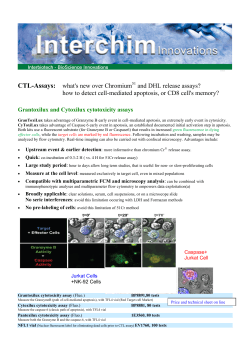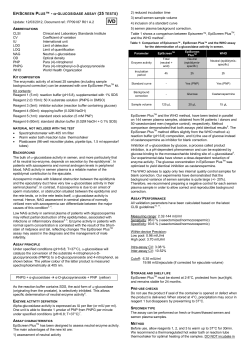
Harness the Power of Glo for Cancer Research CellTiter-Glo
Harness the Power of Glo for Cancer Research CellTiter-Glo® Luminescent Cell Viability Assay Determine viable cell number through bioluminescent quantitation of the viablity biomarker, ATP. • Sensitive: Detect as few as 10 cells in 384well format; 50 cells in 96-well format. • Simple: Homogeneous add-mix-measure assay. No cell washing or removal of culture media. • Fast: Data can be recorded 10 minutes after reagent addition. • Robust: Stable luminescent signal with half-life generally >5 hours. CytoTox-Glo™ Cytotoxicity Assay Determine cytotoxicity through loss of membrane integrity with the cytotoxicity biomarker, “dead cell” protease. • Sensitive: Detect as little as a 2-5% decrease in viable cell number in a population of 10,000 cells. • Simple: Homogeneous add-mix-measure assay. No cell washing or removal of culture media. • Fast: Data can be recorded 15 minutes after reagent addition. • Flexible: Determine total cells per well with optional total cell lysis protocol. Cell lysis reagents included. Investigate mediators of cancer cell viability/cytotoxicity with sensitive bioluminescent tools. Harness the Power of Glo for Cancer Research Ordering Information Product Size CellTiter-Glo® Luminescent Cell Viability Assay CytoTox-Glo™ Cytotoxicity Assay New in 2008 Fisher Cat. # 10ml PRG7570 10 x 10ml PRG7571 100ml PRG7572 10 x 100ml PRG7573 10ml PRG9290 5 x 10ml PRG9291 2 x 50ml PRG9292 CellTiter-Glo® Luminescent Cell Viability Assay contains CellTiter-Glo Substrate and CellTiter-Glo Buffer. Mixing of the CellTiter-Glo Substrate with the CellTiter-Glo Buffer creates the CellTiter-Glo Reagent. Each milliliter of CellTiter-GloReagent give 10 x 100µl assays in a 96-well plate or 40 x 25µl assays in a 384-well plate. CytoTox-Glo™ Cytotoxicity Assay contains AAF-Glo™ Substrate, Luciferin Detection Reagent, Luminescent Assay Buffer and Digitonin. Mixing of the AAF-Glo Substrate with Luciferin Detection Reagent creates the CytoTox-Glo Reagent. Each milliliter of CytoTox-Glo Reagent give 20 x 50µl assays in a 96-well plate or 80 x 12.5µl assays in a 384well plate. Sufficient buffer and digitonin supplied to treat every well for total cell luminescence following dead cell luminescence determination. CytoTox-Glo and AAF-Glo are trademarks and CellTiter-Glo is a registered trademarks of Promega Corporation. Product may be covered by issued or pending patents. Please visit www.promega.com for more information. Recent citations for the CellTiter-Glo Assay in cancer research Bakkar, N., et al. (2008) IKK/NF-κB regulates skeletal myogenesis via a signaling switch to inhibit differentiation and promote mitochondrial biogenesis. J. Cell Biol. 180, 787-802. Beitzinger, M., et al. (2008) p73 poses a barrier to malignant transformation by limiting anchorage-independent growth. EMBO J. in press. Dedieu, S., et al. (2008) LRP-1 silencing prevents malignant cell invasion despite increased pericellular proteolytic activities. Mol. Cell. Biol. In press. Dip, R., et al. (2008) Global gene expression profiles induced by phytoestrogens in human breast cancer cells. Endocr. Relat. Cancer 15, 161-73. Holm, R., et al. (2008) Expression of ZNF652, a novel zinc finger protein, in vulvar carcinomas and its relation to prognosis. J. Clin. Pathol. 61, 59-63. Lin, W.M., et al. (2008) Modeling genomic diversity and tumor dependency in malignant melanoma. Cancer Res. 68, 664-73. Liu, Y.-Y., et al. (2008) A role for ceramide in driving cancer cell resistance to doxorubicin. FASEB J. in press. Pühler, F. et al. (2008) Generation of a recombinant oncolytic Newcastle disease virus and expression of a full IgG antibody from two transgenes. Gene Therapy 15, 371-83. Tsai, J., et al. (2008) Discovery of a selective inhibitor of oncogenic B-Raf kinase with potent antimelanoma activity. PNAS 105, 3041-6. Yaba, A., et al. (2008) A putative mitotoic checkpoint dependent on mTOR function controls cell proliferation and survival in ovarian granulosa cells. Reproductive Sciences 15, 128-38 Zhdanov, A.V., et al. (2008) Dynamics of intracellular oxygen in PC12 cells upon stimulation of neurotransmission. J. Biol. Chem. 283, 5650-61.
© Copyright 2025





















